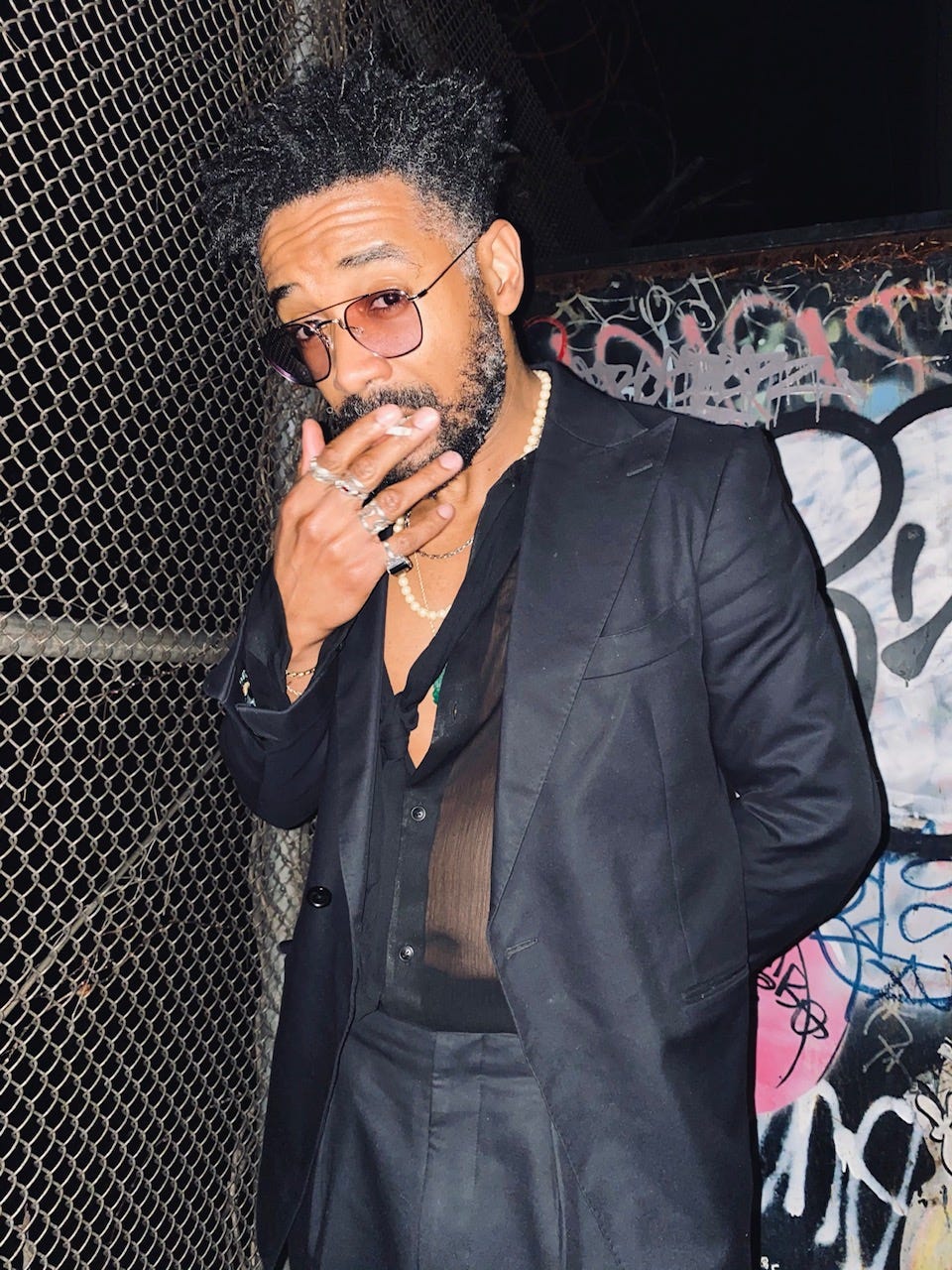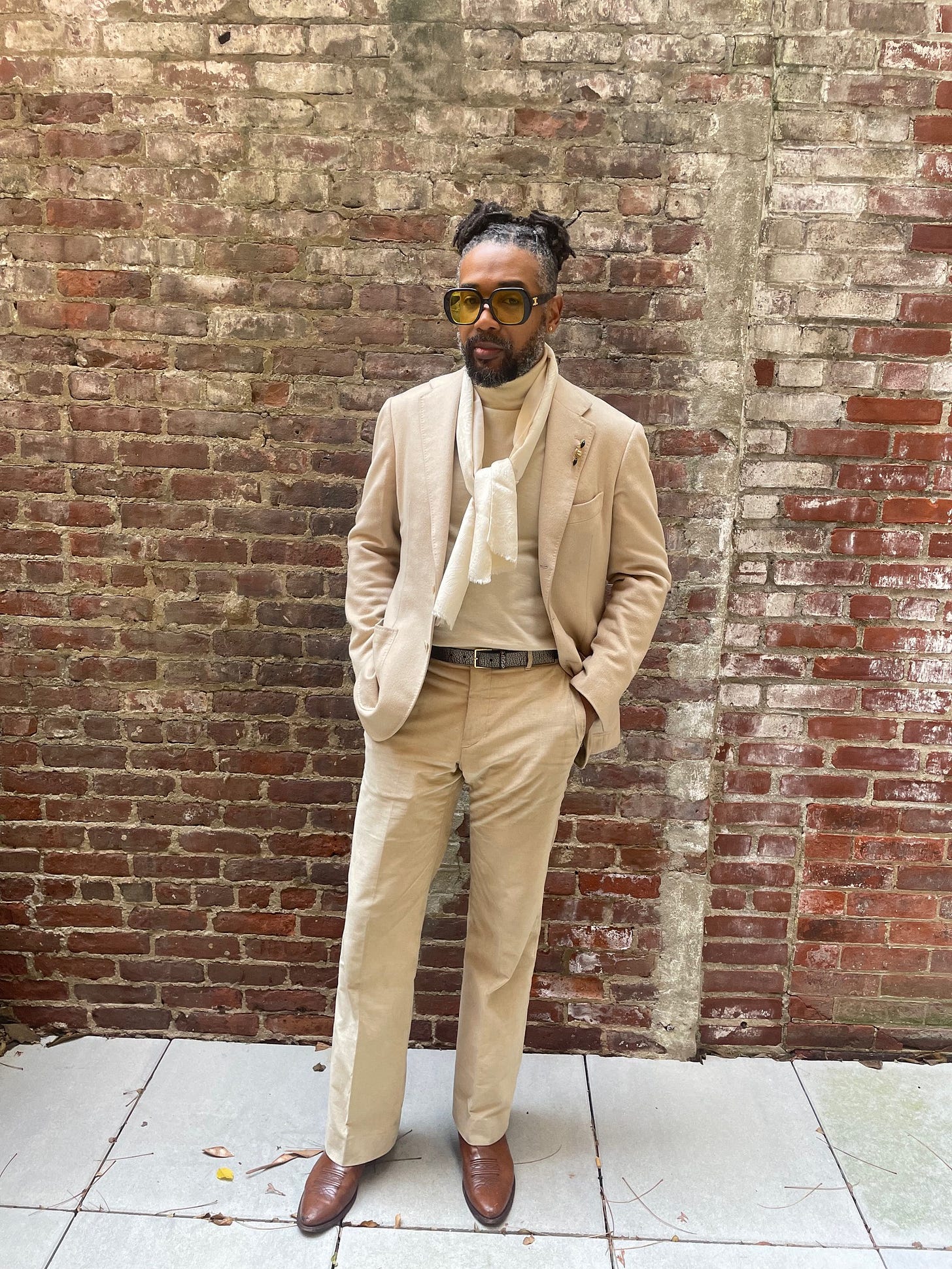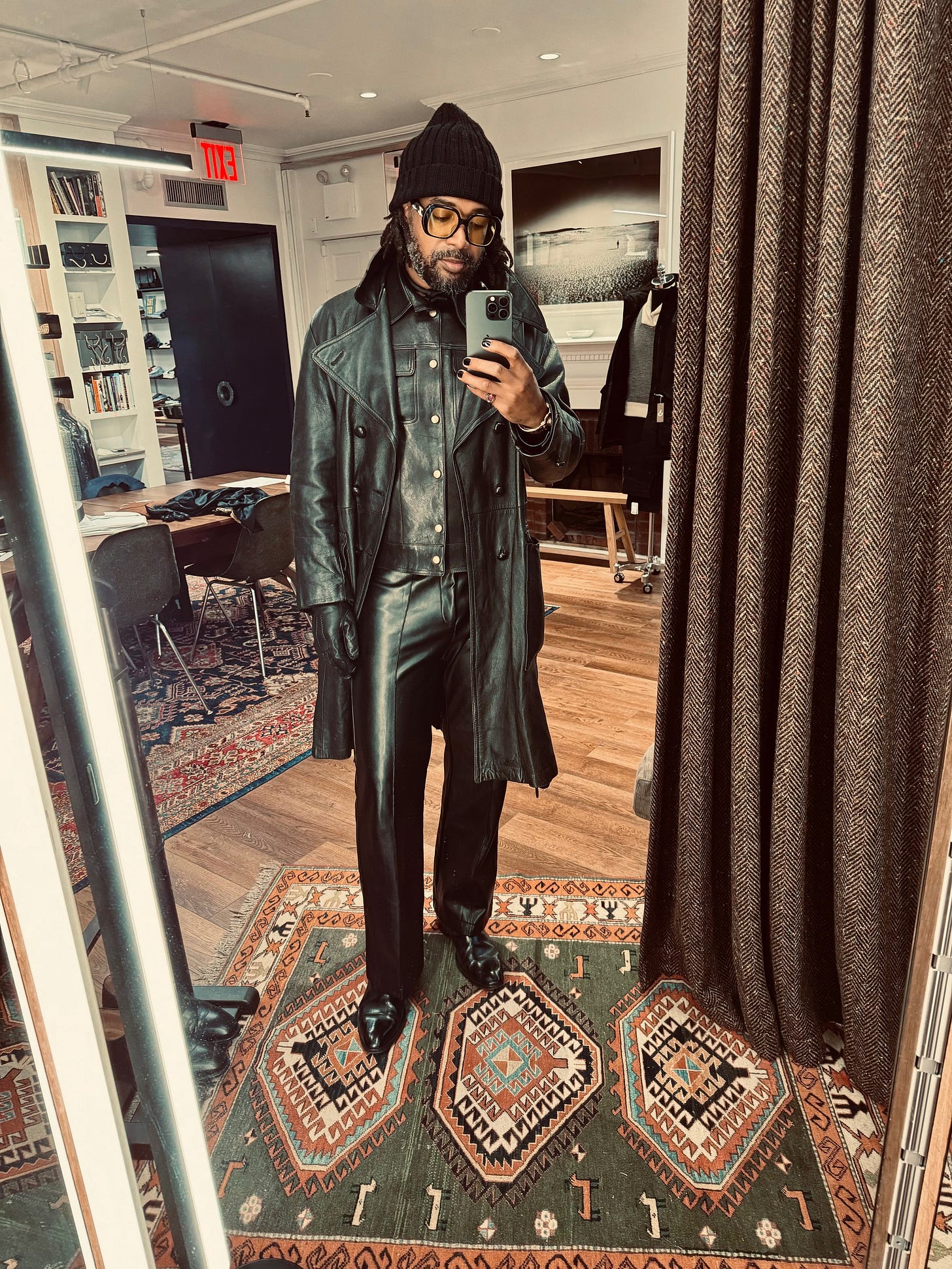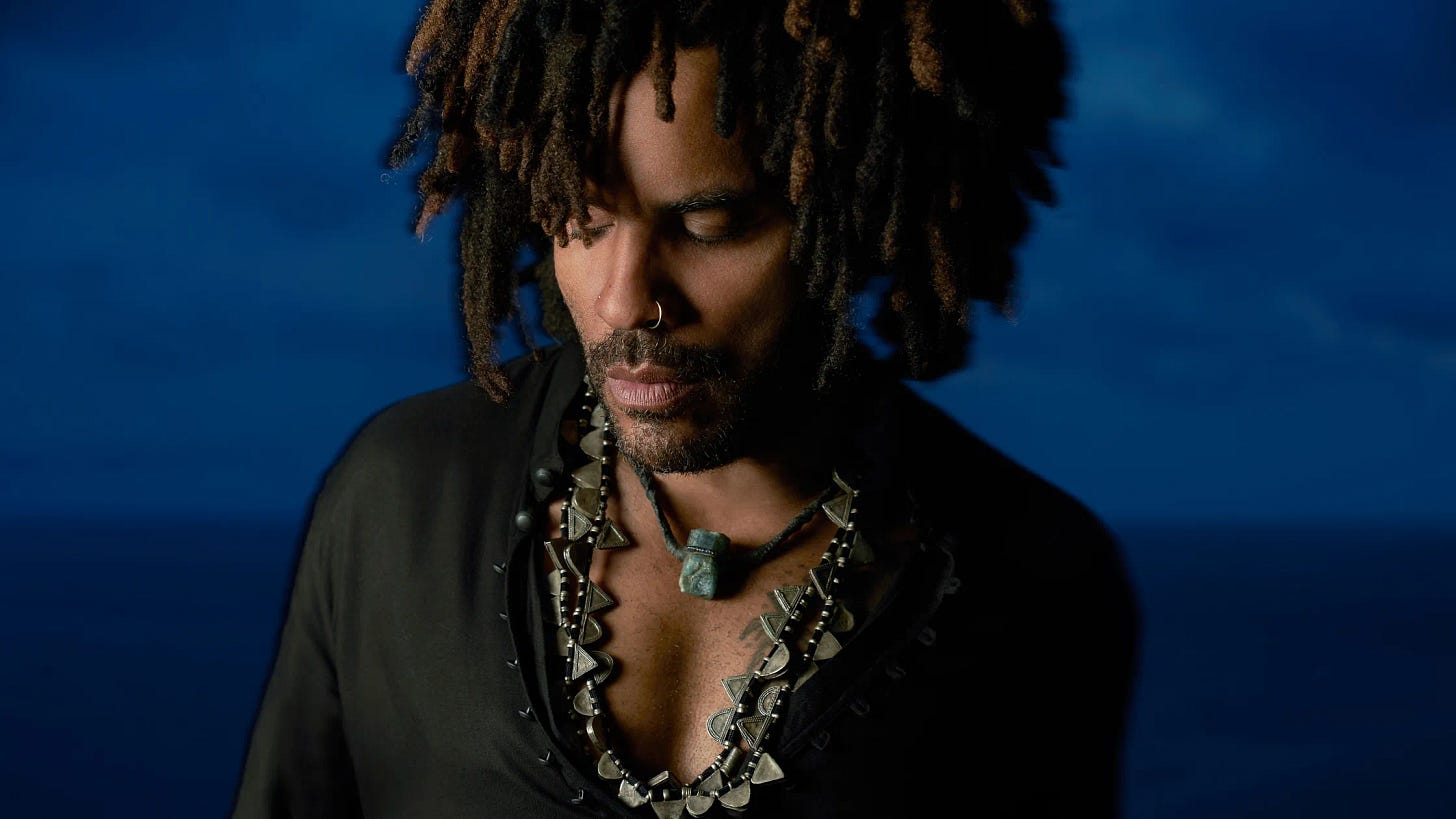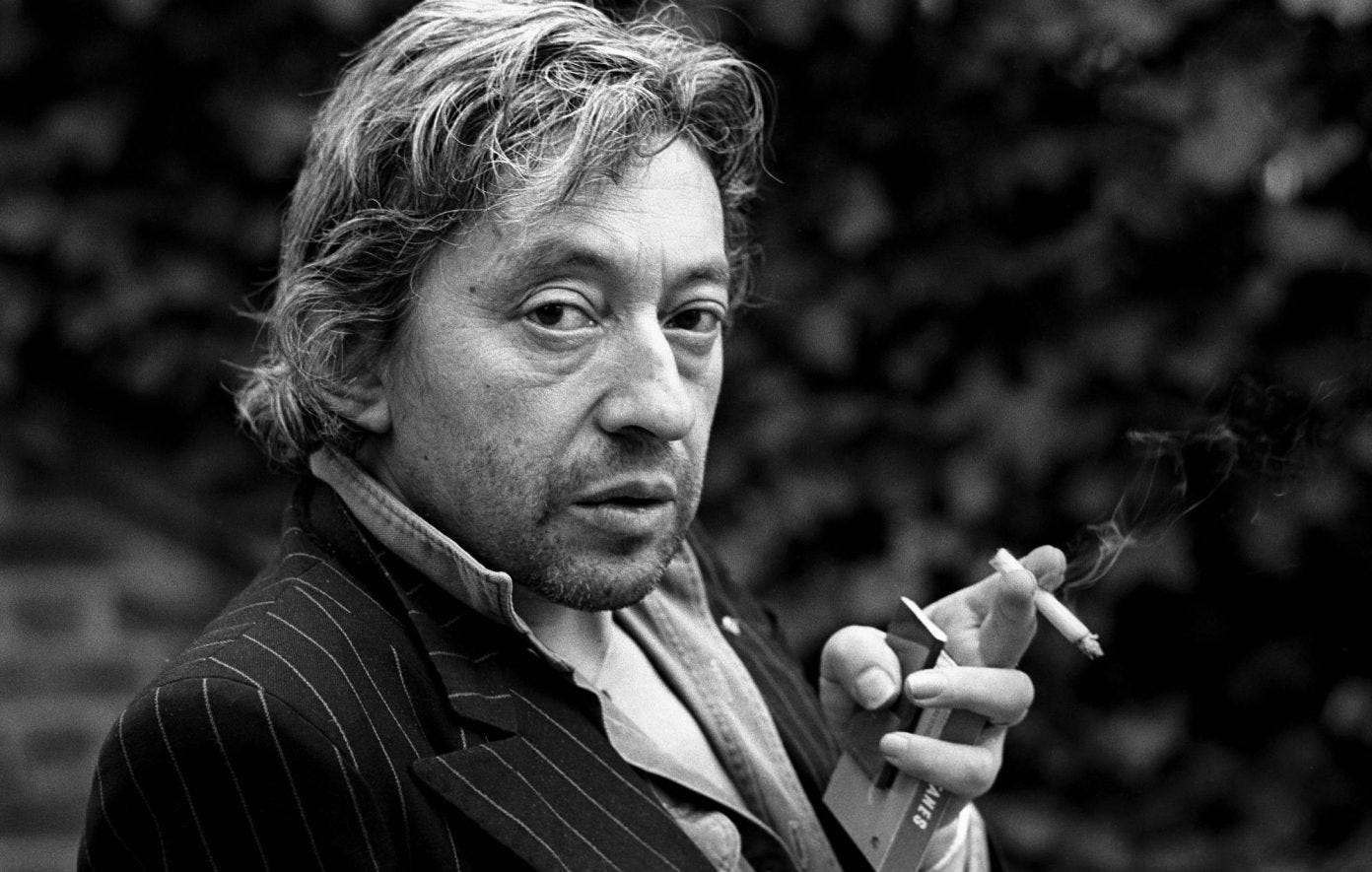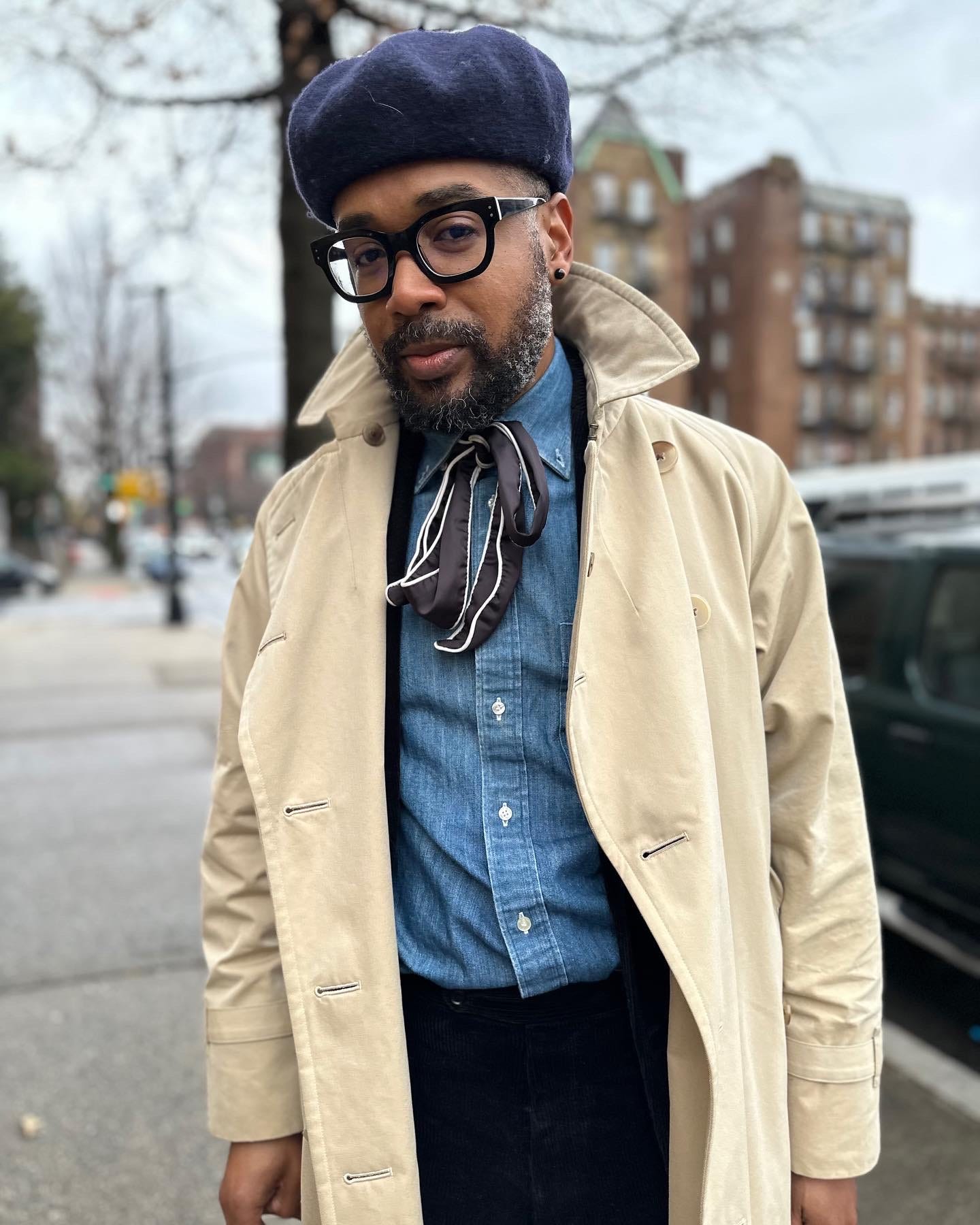Issue #13 | Q&A With Kamau
A wide-ranging conversation about menswear and style with Kamau Hosten of The Armoury
Kamau Hosten is one of the most stylish guys you’ll ever come across—creative, considered, fully himself in his style. I met him a few weeks ago at The Armoury in the Upper East Side. I was there to check out some of the shop’s tailored jacket options. Kamau walked me through the various models and bespoke offerings. He was insightful, honest, and not at all intimidating.
Kamau was wearing a bespoke navy jacket by the renowned Tailor Caid; custom houndstooth pants from Rota; and an incredible assortment of accessories. It was a great look—entirely unique and elaborate without being ostentatious. That same sensibility is reflected in his own brand, Kamsten.
I reached out to Kamau for an interview and we met this week at a café in Prospect Lefferts Garden in Brooklyn. It was freezing out and pretty much everyone in the coffee shop was wearing a puffer, jeans, and boots. Kamau, however, was in a vintage leather coat he picked up in a Toronto vintage store; a white shawl cardigan over a herringbone vest; black jeans and Chelsea boots; and matching gold rings, watch, and earnings, with yellow tinted, thick-framed Celine glasses. You would have been forgiven for thinking he was a movie or rock star.
Kamau has been into clothes since he was a kid. He wore ties and pleated trousers in school, where his classmates teased him. But he became comfortable standing out, and the experience was the foundation for his personal style today. “It’s a joy to just keep tweaking and finding my own personal style—what I want to project to people,” he says. “That’s the part of style where you want to get to, where it’s uniquely and entirely yours.”
Here are excerpts from our wide-ranging conversation on his personal style and advice for the rest of us. It’s been edited for length and clarity.
So I wonder if you could start by talking about your own background as it relates to menswear and developing your own personal style. Where did that start?
Like a lot of these guys, I got into it as a kid. My grandmother was a seamstress when she was studying in nursing school.
She had moved from Trinidad to London and that was sort of how she made her way through nursing school. So that was always around and my mother picked it up, so I was always around clothing growing up. They made their own clothes. I made my pajamas when I was a kid.
Was this here or in London?
This was in Florida. I was born in Trinidad, moved to Florida as a kid. And I’m telling you, it was fucking awful to be a boy sitting in a fabric store, because I would just sit there and be like, “All right, what are they doing?” Just totally losing my mind. But I must have absorbed subconsciously some of it where now I can look at fabrics and really appreciate the details. It must’ve been from then.
And then I think there’s definitely a West Indian approach to dressing. Similar to, I think, Black Americans where we are judged more harshly. So we want to step out, like when you go out of the house you want to be... You’ve got to be fresh. At church, with weddings, interviews. Here’s my leg up. I at least have to look the part... Just being put together was always a part of life.
And then I just kept getting into it, and then I think middle school hit and like shit, women, girls are really... they’re not really digging me, right? Maybe if I’m fresher than the other dudes… It really didn’t work [laughs]. But I really kind of honed it in and started paying attention to brands. I was wearing ties and pleated trousers.
Oh, really?
In high school. Yeah, yeah. I would always get those comments, “Are you going to church afterwards?” But whatever.
Just owned it.
Yeah, you have to. I think that’s learning from a young age, you have to just absorb it all. You could look back and realize, “Oh, no one else is dressed like this. I am, it is just me.” Look at this classroom, here’s this kid with a tie. But I think that sets you up for now when you’re on the train looking at the trousers, looking at your topcoat. Sometimes you notice that everyone else is in puffer coats, right? Which I was in one earlier today. But I think it’s being comfortable standing out. And not just standing out, but looking polished.
Then I just more and more I got into the industry, dug into it. The books of Bruce Boyer, Alan Flusser, because I’m in the middle of Florida. So it’s not like I could just go to a department store and poke around. I didn’t find what I was looking for in magazines, so I went into the bookstores looking at those guys. And then I started going vintage shopping armed with my new knowledge… and take it to the local tailors. “Hey, can you do this? Can you chop this size 40 down to a 38?” And it’s just a lot of trial and error. It was fun though. There were some pieces that I remember I really loved.
And then I just got into the industry. I got a job in journalism. I wrote for a newspaper in Florida. And then moved to Miami, started working retail from the ground up. I worked at Brioni. And then that’s the opportunity that brought me here.
To New York?
Yeah, I was doing merchandising, and since then it’s everything. It’s copywriting, it’s wholesale, retail, some photography, lot of marketing. Then that all birthed into my own brand. My own outlook and approach to what I think is flattering. And there is also my work with The Armoury, which is a hybrid of sales and art direction.
But it’s such a fun world. And with Mark [Cho, The Armoury Founder], what’s nice about them is there’s not a singular aesthetic. You have other brands that are like, that this is how you look… But The Armoury’s about finding your style within this space of amazing craftspeople. And that’s really what I, in principle, would want to impress upon people there, but also in my own approach, in my own brand.
Bruce Boyer always had that great quote: You’re not curing cancers. This shit’s got to be fun. You’ve got to approach it with light-heartedness. When you start freaking out or obsessing about the stitching or lapel work or anything like that, that’s when it stops being fun and starts getting just technical and foreign.
So how do you describe your own style?
Hmm. I’ll say my inspirations: There’s Nile Rogers. Lenny [Kravitz]. Serge Gainsbourg. Taking tailoring and making approachable, easy, a little cooler always look at those guys as my primary inspirations…
Excellent socks, by the way.
They’re Rototo. Japanese brand.
Fantastic.
So I looked at your brand’s website. I wonder if you could describe it for me.
I want to say I went for the guy who doesn’t go to the boardroom. He wants to step it up, he wants to step out at night… I did a lot of deeper V, one button peak lapel. And then the flowier trousers, which you’re seeing quite a bit of now. It’s very louche. I think that’s a very nice word to sort of encapsulate my approach to it.
It’s like if you took a jacket and you ripped out the padding, the canvassing, that’s the sense that I wanted to get. It’s ease. It’s movement…
OK, let’s say you’re my style consultant, and I came to you saying I don’t really have any tailoring to speak of. My suits don’t fit. I don’t have any jackets. Where should I start?
I would ask, number one, what is your day to day like? What do you need? Because you can go Permanent Style or you can go to Mr. Porter, and they’re going to tell you, Here’s 20 essentials that you need. But what do you do day- to-day? How often do you need a jacket?
There are some foundations that I think are still correct. You can still look good if you know the proportions of a jacket. Medium lapel, in a hopsack. That’s still a great cornerstone. Denim shirt and a white shirt. Two really great pieces. And then, if you need to be on the more polished side, great trousers. I think those basic pieces will do you well.
Where I divert? Black Chelsea boots. They look great with jeans, great with trousers. You can wear them on a date, you can wear them to a funeral, you can wear them to a wedding….
I do think, if you needed a suit, I still think a navy suit is pretty darn good.
Yeah.
Because, once again, white shirt, light blue shirt, blue tie, cool. But navy suit, black turtleneck with boots, then you’re ready to be... to kind of feel yourself a little bit. That’s what you should want. You should feel yourself, versus, “Am I doing all this right? Look at the square, am I showing my half of a centimeter of the square? Okay. Let me go back to the Instagram post and check.”
So if you were going to get a navy suit, other than The Armoury, where would you want to look?
I’ll do budget points. So if you’re on a budget, there’s Spier & Mackay. They’re strictly an e-commerce brand.
Are they Canadian?
Yes, they are. I don’t have any personal experience, but what I have heard is the product for the value is incredible. I think Todd Snyder is a great shop. And obviously The Armoury. Their Model 3 I think is pretty close to perfect silhouette for most guys. I’ve put it on enough people to say the proportions flatter nearly every guy. But if you’re going to bespoke, the sky is the limit.
What about blazers and sports coats? When I saw you in your own jacket, the Tailor Kaid, I was like, “Wow, that is fucking awesome.” But I can’t quite figure it out for myself because when I go in and try something on, nothing feels right. How do you introduce the idea of wearing jackets and blazers to people?
I'll say, Listen, you’ve got to start painting a picture, because I don’t want you to buy a jacket because, “Okay, I have to do three weddings.” Because you’re spending this money and I want you to get the most out of this investment. I’ll say, “Listen, take this jacket, think about this jacket, the same jacket with a black polo, black denim, black loafers, blue pants.”
So immediately I want you to think of a different agenda, outside of the context of what you’re thinking about. “Oh, I have a wedding.” Okay, that’s cool. But don’t let this shit just sit in the closet until the next wedding. Here’s how to do it. And throw this on over a great T-shirt.
I never want anyone just having a piece that sits there. Use it. I think the more you wear it, the more you’ll become comfortable with it. Especially when you’re armed with the advice of, “Oh, I can do this. This is how to break it up.” And that’s what I want to do.
I remember GQ used to say never ever break up a suit. And I think they were talking more about a traditional formal suit.
Yeah.
But now places like Drake’s sell jackets and pants separately, but you can also put them together as a suit. What are your thoughts on breaking up a suit?
It’s depending on the fabric. If it’s a flannel suit, you can break that up easily, because you can take those mid-gray flannel trousers, you can put on a navy turtleneck and a denim jacket. You’ve got yourself a really cool outfit. You can take that same mid-gray flannel jacket, you can pair it with dark black denim. You can do a clean white shirt, scarf, loafers, and then you can go out. And you can take it and you can pair it with denim, you can pair it with Jordan’s. It’s playing with all these different ways, but it is dependent on the type of fabric.
How do you approach getting dressed each day? I once read that LeBron James picks what shoes wants to wear and goes from there. For me, I’ll usually think of one thing I want to wear and then build everything around that. What’s your approach?
I tend to think about what I want to project that day. Do I want to be a softer, more tailored version? Do I want to wear this matching Model 6 with gold buttons? Gray micro houndstooth trousers? Gray brushed cotton shirt? Do I want a more sartorial look today? What’s the mood?
What about jewelry and accessories? I think that’s another area people can find intimidating. I don’t know if I can pull off all these rings. How did you develop your approach to accessories?
I’ve always loved jewelry. I’ve always liked the expressive nature of it. I think the key is, it has to be pieces that are unique to you. Because if you just say, “Oh, I’m going to put on a ring,” it’s gonna feel fine. But if you look at it and think, “Oh, okay, this is from more than 20 years ago,” or, “This I was wearing when we got engaged,” or, “This was a 40th birthday present. Oh, this we got in Paris. Here’s my wedding ring with my second ring I had made.” So all that becomes part of you and your journey and story. And I think that’s, for me, just an extension of the story.
Where’s menswear heading next?
I’ve seen clothing that are a little flowier. I’m not talking wider, workwear things. I’m talking flowier trousers, flowier sports coats, flowier jackets. Because it isn’t about the buttoned-up look.
But I think on the other side, I think there’s going to be a return to formal, because [people are saying], “Now, wait a second. I don’t want to wear this stuff for all time. I want to wear a real pair of shoes that aren’t something practical.” So I think we’re seeing that. We’re seeing more democratic menswear on the red carpet. But it’s not 30 big guys in vaguely similar tuxedos. You’re seeing flowier trousers, you’re seeing crop jackets, you’re seeing no shirt. People are saying, “Fuck it.”
That just reminded me of another question: What are your favorite vintage shops?
So there’s a good spot I love. It’s over here on Flatbush, Granru Market. That’s a great store. Unearth Vintage. There’s No Relations Vintage in Bushwick. That one’s really good. Oh, Superette in Chinatown. Pippin Vintage Jewelry. I’ve been going there for years. I got my wife’s engagement there.
This is great. Really appreciate it. It’s super, super helpful and insightful.
My pleasure. Hey, thanks for reaching out.
Yeah, thanks for taking the time.
Question? Comment? Suggestion? Caught a typo? Email me at mitch.moxley@gmail.com



